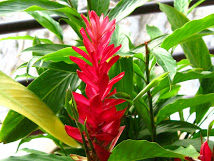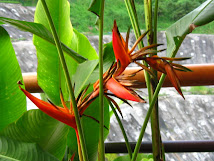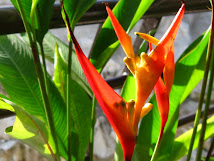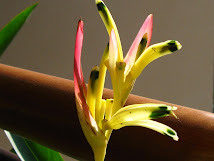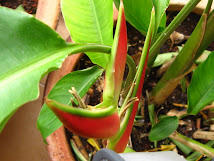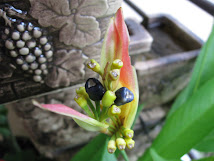Welcome to Heliconias... Heliconias... Heliconias
This blog is all about growing Heliconias, an exotic plant not native to Malaysia. All pictures shown are digital photos of the actual species in my garden such as Rostrata, Dwarf Jamaican, Latispatha and several psittacorums such as Andromeda, Lady Di, Fuschia, Strawberry & Cream and hybrids such as Golden Torch and Alan Carle.
Heliconia are close relatives of gingers, bananas, birds-of-paradise and traveler’s palms. There are more than 200 (350 including cultivars) documented species of the single genus, with the bulk of them originating from Central and South America such as Guyana, Costa Rica, Berlize, Ecuador, Peru and Brazil. You may be interested to note that about 6 species have evolved separately in the South Pacific and Indonesia, and typically have green inflorescence.The name "heliconia" actually comes from Greek mythology after the great Mount Helicon, the abode of the muses of the arts and sciences.
The beauty of the heliconia lies in the brightly coloured bracts that are mistakenly called the flowers. The actual flower is the tiny little flowers that emerge from the large showy bracts. Each stem can only flower once, after which the entire stem deteriorates, drives up and collapses. As such, it is recommended to cut at the base of 'flowered-out' stems.
BTW, this blog has been read by visitors from Australia, Brazil, Chile, Colombia, France, India, Japan, Malaysia, Philippines, Puerto Rico, Mexico, Netherlands Antilles, Netherland, Singapore, Spain, Thailand, Trinidad & Tobago, United Kingdom & United States of America :-)
16th Sept 2009 : 17:30
Heliconia are close relatives of gingers, bananas, birds-of-paradise and traveler’s palms. There are more than 200 (350 including cultivars) documented species of the single genus, with the bulk of them originating from Central and South America such as Guyana, Costa Rica, Berlize, Ecuador, Peru and Brazil. You may be interested to note that about 6 species have evolved separately in the South Pacific and Indonesia, and typically have green inflorescence.The name "heliconia" actually comes from Greek mythology after the great Mount Helicon, the abode of the muses of the arts and sciences.
The beauty of the heliconia lies in the brightly coloured bracts that are mistakenly called the flowers. The actual flower is the tiny little flowers that emerge from the large showy bracts. Each stem can only flower once, after which the entire stem deteriorates, drives up and collapses. As such, it is recommended to cut at the base of 'flowered-out' stems.
BTW, this blog has been read by visitors from Australia, Brazil, Chile, Colombia, France, India, Japan, Malaysia, Philippines, Puerto Rico, Mexico, Netherlands Antilles, Netherland, Singapore, Spain, Thailand, Trinidad & Tobago, United Kingdom & United States of America :-)
16th Sept 2009 : 17:30
Monday, October 27, 2008
Watching Flower Growth : Fuschia
 16th November 2008
16th November 2008 15th November 2008
15th November 2008 14th November 2008
14th November 2008 13th November 2008
13th November 2008 11th November 2008
11th November 2008 10th November 2008
10th November 2008 8th November 2008
8th November 2008Notice that all the perianths have already fallen off and we can see the blackening of some of the ovaries. Fruiting ?
 7th November 2008
7th November 2008 6th November 2008
6th November 2008 5th November 2008
5th November 2008 4th November 2008
4th November 2008 2nd November 2008
2nd November 2008 1st November 2008
1st November 20081 perianth left...
 29th October 2008
29th October 2008 28th October 2008
28th October 20082 perianths left...
 27th October 2008
27th October 2008 25th October 2008
25th October 2008 24th October 2008
24th October 2008 21st October 2008
21st October 20083 perianths still visible...
 20th October 2008
20th October 20083 perianths left...
 20th October 2008
20th October 20084 perianths left with bottommost opening...
 19th October 2008
19th October 20085 perianths visible and leftmost perianth has opened ie expected to drop off tomorrow...
 18th October 2008
18th October 20086 perianths visible
Watching Flower Growth : Strawberry & Cream
Sunday, October 26, 2008
Anatomy of Inflorescence

The beauty of the heliconia lies in the brightly coloured bracts that are mistakenly called the flowers.
The actual flower is the tiny little flowers that emerge from the large showy bracts. The flower group (called an "inflorescence") is almost always at the end of long, leafy shoots.The stem is either erect or drooping , with respect to the leafy shoot from which it emerges. The inflorescence is made up of the peduncle and modified leaf-like structures known as bracts.
The rachis connects adjacent bracts. Within each bract there is a coil of inconspicuous flowers.
The fruits also develop within the bracts. The bracts are often filled with water and house a distinctive aquatic micro-ecosystem.
Monday, October 20, 2008
Watching Flower Growth : Lady Di
 16th November 2008
16th November 2008 14th November 2008
14th November 2008 13th November 2008
13th November 2008 12th November 2008
12th November 2008 10th November 2008
10th November 2008 9th November 2008.
9th November 2008.All perianths have dropped off and all we can see is the decaying 3 red bracts and the yellow ovaries.
In the coming days, we can only expect to see fruiting and decaying red bracts.
 8th November 2008.
8th November 2008.Still 1 perianth left...
 7th November 2008.
7th November 2008.As expected, there is 1 perianth left.
 6th November.
6th November.2 perianths left and the topmost starting to open.
We can expect it to drop off by tomorrow.
 5th November 2008
5th November 2008The rightmost perianth is starting to open and will drop off by tomorrow...
 4th November 2008.
4th November 2008.Another perianth is starting to open...
 3rd November 2008.
3rd November 2008.As expected, there only 3 perianths left.
 2nd Nov 2008.
2nd Nov 2008.4 perianths are visible. You should notice that the topmost perianth is glowering and will drop off by tomorrow.
 1st November 2008
1st November 2008Only 5 perianths left...
 31st October 2008
31st October 2008Perianths are looking sticky yellow and there are 6 left with the top right opening.
 28th October 2008
28th October 2008Yes, the perianth actually dropped of yesterday evening .
 27th Oct 2008
27th Oct 2008Did you notice the opening of the leftmost petals as it flowers. I expect the perianth to drop off tomorrow, and exposing the ovary.
 26th October 2008
26th October 2008Moved to LH of balcony.
As expected, one of the perianth has dropeed off.
10 perianths visible
 25th November 2008
25th November 2008Rightmost perianth starting to open and should drop off by tomorrow.
 24th October 2008
24th October 20089 perianths clearly visible
 21st October 2008
21st October 20088 yellow perianths are now visible.
 20th October 2008
20th October 20086 yellow perianths are now visible.

19th October 2008
4 yellow perianths are now visible and the 3 red bracts are still vertical.
17th October 2008, Starting to monitor flowering process

Subscribe to:
Posts (Atom)



.jpg)










